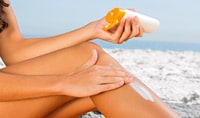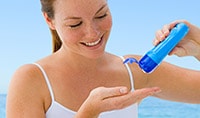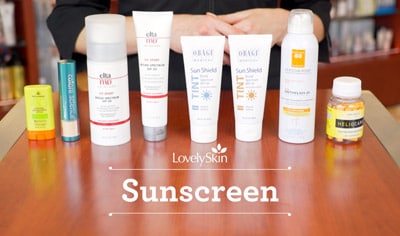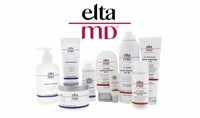
Each year on May 27, we take a moment to celebrate warm summer weather on the horizon, and remember the single best safety measure against harmful UVA and UVB rays: sunscreen. In honor of National Sunscreen Day, we’ll take you through a brief history of sunscreen and leave you with some helpful reminders for getting the most out of your favorite products.
History of Sunscreen
The first sunscreens date back to ancient Egypt. Egyptians desired to keep skin fair and free of sun damage, but the intense sunlight made avoiding tanning or burning difficult. They developed potions made from healing and UV-absorbing substances like rice bran extract, jasmine and lupine, ingredients that are still found in many of today’s modern sunscreens. Other ancient civilizations around the world used olive oil, various plant extracts and pastes made from zinc oxide to prevent burning.
Chemists first began to develop commercial sunscreens in the 1920s, with the first major prototype introduced to the American market in 1936. In 1938, chemist Franz Greiter invented his Gletscher Crème (Glacier Cream) after suffering a severe sunburn while mountain climbing. The cream had an estimated SPF of 2 by today’s standards. Greiter would go on to formally invent SPF, or Sun Protection Factor, in 1962, which is still used today for rating a sunscreen’s protection level.
Sunscreen would still take many more years to catch on with the general public. The first widely used sunscreen was produced in 1944 by a physician named Benjamin Green. Developed exclusively for those U.S. troops stationed in the south Pacific region during World War II, it was called “Red Vet Pet,” short for red veterinary petrolatum. The sticky red petroleum jelly acted as the best known physical blocker against ultraviolet rays. Luckily, Green was able to reformulate “Red Pet Vet” in the 1950s, and the new product was similar to the cosmetically elegant, pleasantly scented formulas we use now.
In 1977, water-resistant formulas were introduced, forever changing the market, and today, sun protection products continue to evolve and grow more effective all the time. Companies are focusing on producing broad spectrum sunscreens in a multitude of different formulations that appeal to every need and skin type. Sunscreen ingredients have also begun to find a place in other types of beauty products, such as primers, serums, foundations, moisturizers, eyeshadows and lip products, and many formulas also offer antioxidant protection and other anti-aging benefits.
How Sunscreen Works
Sunscreen helps to shield skin from UV rays that are emitted by the sun. There are two types of UV Rays—UVA rays and UVB rays. UVA rays cause skin to tan, and they are also responsible for most signs of aging. You can think of the A in UVA as “A for aging” to help you remember. Though UVA rays are technically less intense than UVB rays, they penetrate more deeply and cause more damage over time. Ninety-five percent of UV exposure is comprised of UVA rays, and they can reach the skin through clouds and windows. This is why you should always wear sunscreen, rain or shine, even if you plan to spend the day indoors.
UVB rays are far more intense than UVA rays, and they cause most surface damage. Think of the B in UVB as “B for burning.” UVB rays cause reddening in the outer layers of the skin, and they are even more powerful at high altitudes or when reflected off of water, snow or ice. Both UVA and UVB rays contribute to premature signs of aging, eye damage and skin cancer.
Decoding Your Sunscreen Bottle
Your sunscreen label can tell you everything you need to know about the level of UVA and UVB protection you’re receiving, beginning with SPF. SPF stands for Sun Protection Factor, and it measures protection against UVB rays, the rays primarily responsible for burning and surface damage. The number that follows is intended to be a rough estimate of how long you can stay in the sun without burning. For example, if you are using a sunscreen with an SPF of 15, and your skin typically burns within 20 minutes of sun exposure, you should theoretically be able to stay in the sun about 15 times longer than 20 minutes, or five hours, without burning. We must again emphasize that this is a rough estimate. There are many factors that can affect a sunscreen’s ability to protect such as skin type, sun intensity and perspiration. Most dermatologists recommend a sunscreen with an SPF of 30, and no matter what sunscreen you choose, you should reapply every two hours.
Many sunscreens also include a PA, or Protection Grade rating. A sunscreen’s PA tells you the amount of protection you’re receiving against UVA rays. You should see PA, followed by a number of plus signs. The more plus signs after PA, the more protection you’re receiving against UVA rays.
When choosing a sunscreen, always look for the words “broad spectrum,” a term that means that the formula protects against both UVA and UVB rays. Fortunately, the vast majority of today’s sunscreens offer broad spectrum protection, but it is always best to verify. We also recommend choosing a water-resistant formula, especially if you plan to spend an extended period of time swimming or being active outdoors. These sunscreens can stay effective up to 80 minutes, even through water and perspiration.
How to Use Sunscreen Effectively
Applying sunscreen will go a long way to keeping you shielded from harmful rays, but knowing how and when to apply it will allow you to maximize your benefits. Here are some hints for getting the most out of your sunscreen:
• Apply one ounce of sunscreen (about one shot glass worth) to the face and body. Don't forget the ears, neck and backs of hands. If you’re concerned about breakouts, try an acne formula like EltaMD UV Clear SPF 46 Broad Spectrum Sunscreen.
• No matter the SPF of your sunscreen or its claims of water resistance, always reapply every two hours or immediately after sweating or swimming. There is no such thing as too much SPF. Apply more whenever you feel the need.
• Always wear sunscreen, rain or shine, and even if you plan to spend most of the day indoors. UV rays can penetrate car and office windows and cause premature signs of aging. Apply sunscreen no matter your skin tone.
• Seek shade when possible and cover up with a hat, sunglasses, long sleeves and pants for even more protection.
• Avoid peak sunlight between the hours of 10 a.m. and 4 p.m.
• Take Heliocare, an oral supplement that offers antioxidant protection against UV rays. Though the capsules are not a replacement for sunscreen, they can help skin build a resistance against UV damage, and they make a wonderful daily accompaniment to sunscreen application.
Do you have a question about sunscreen? Let us know on Facebook, Twitter or Instagram using #LovelySkin.
Shop this blog

About the Author
Stepha is a copywriter at LovelySkin. She loves poetry, baking and experimenting with new makeup.
Other Posts by StephaFollow us on social
Follow us on social networks and be one of the first to learn about sales, giveaways, and free samples







